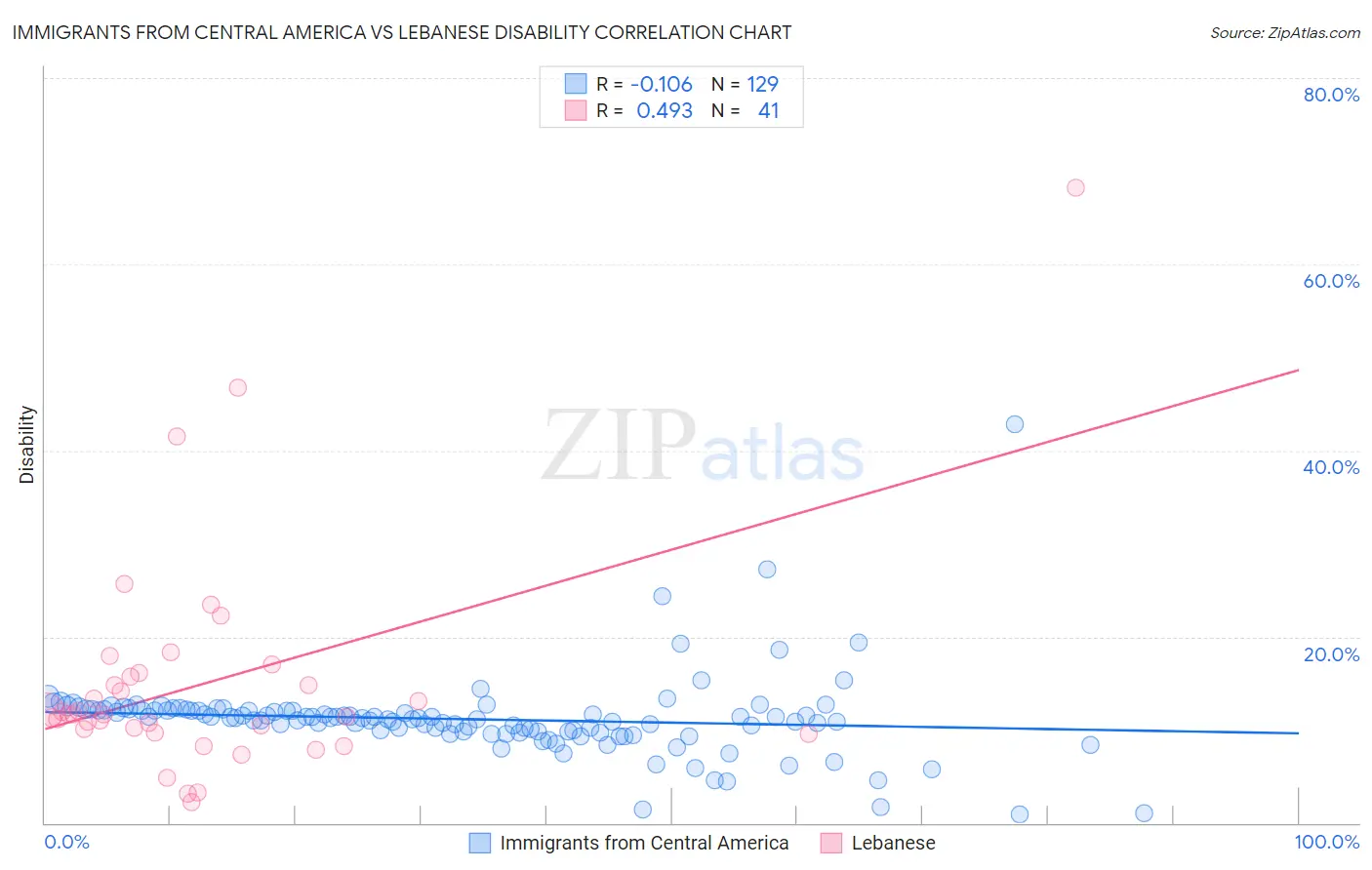Immigrants from Central America vs Lebanese Disability
COMPARE
Immigrants from Central America
Lebanese
Disability
Disability Comparison
Immigrants from Central America
Lebanese
11.7%
DISABILITY
46.6/ 100
METRIC RATING
177th/ 347
METRIC RANK
11.8%
DISABILITY
27.9/ 100
METRIC RATING
187th/ 347
METRIC RANK
Immigrants from Central America vs Lebanese Disability Correlation Chart
The statistical analysis conducted on geographies consisting of 536,390,907 people shows a poor negative correlation between the proportion of Immigrants from Central America and percentage of population with a disability in the United States with a correlation coefficient (R) of -0.106 and weighted average of 11.7%. Similarly, the statistical analysis conducted on geographies consisting of 401,592,225 people shows a moderate positive correlation between the proportion of Lebanese and percentage of population with a disability in the United States with a correlation coefficient (R) of 0.493 and weighted average of 11.8%, a difference of 0.90%.

Disability Correlation Summary
| Measurement | Immigrants from Central America | Lebanese |
| Minimum | 0.89% | 2.2% |
| Maximum | 42.9% | 68.2% |
| Range | 42.0% | 66.0% |
| Mean | 11.1% | 15.0% |
| Median | 11.3% | 11.6% |
| Interquartile 25% (IQ1) | 9.8% | 9.9% |
| Interquartile 75% (IQ3) | 12.1% | 16.0% |
| Interquartile Range (IQR) | 2.3% | 6.0% |
| Standard Deviation (Sample) | 4.4% | 12.1% |
| Standard Deviation (Population) | 4.4% | 11.9% |
Demographics Similar to Immigrants from Central America and Lebanese by Disability
In terms of disability, the demographic groups most similar to Immigrants from Central America are Greek (11.7%, a difference of 0.020%), Immigrants from Western Africa (11.7%, a difference of 0.040%), Haitian (11.7%, a difference of 0.090%), Albanian (11.7%, a difference of 0.15%), and Maltese (11.7%, a difference of 0.18%). Similarly, the demographic groups most similar to Lebanese are Immigrants from Scotland (11.8%, a difference of 0.020%), Immigrants from Burma/Myanmar (11.8%, a difference of 0.030%), Iraqi (11.8%, a difference of 0.11%), Honduran (11.8%, a difference of 0.18%), and Immigrants from Mexico (11.9%, a difference of 0.24%).
| Demographics | Rating | Rank | Disability |
| Trinidadians and Tobagonians | 52.7 /100 | #172 | Average 11.7% |
| Maltese | 50.6 /100 | #173 | Average 11.7% |
| Albanians | 50.0 /100 | #174 | Average 11.7% |
| Haitians | 48.6 /100 | #175 | Average 11.7% |
| Immigrants | Western Africa | 47.5 /100 | #176 | Average 11.7% |
| Immigrants | Central America | 46.6 /100 | #177 | Average 11.7% |
| Greeks | 46.2 /100 | #178 | Average 11.7% |
| Immigrants | Armenia | 41.9 /100 | #179 | Average 11.7% |
| Immigrants | Honduras | 37.8 /100 | #180 | Fair 11.8% |
| Immigrants | Oceania | 34.3 /100 | #181 | Fair 11.8% |
| Icelanders | 34.0 /100 | #182 | Fair 11.8% |
| Hondurans | 31.2 /100 | #183 | Fair 11.8% |
| Iraqis | 30.0 /100 | #184 | Fair 11.8% |
| Immigrants | Burma/Myanmar | 28.5 /100 | #185 | Fair 11.8% |
| Immigrants | Scotland | 28.2 /100 | #186 | Fair 11.8% |
| Lebanese | 27.9 /100 | #187 | Fair 11.8% |
| Immigrants | Mexico | 23.8 /100 | #188 | Fair 11.9% |
| Immigrants | Zaire | 21.8 /100 | #189 | Fair 11.9% |
| Immigrants | West Indies | 21.1 /100 | #190 | Fair 11.9% |
| Ute | 19.5 /100 | #191 | Poor 11.9% |
| Lithuanians | 18.8 /100 | #192 | Poor 11.9% |